Peru 2011
Cusco to Tinqui by Van and Hike to Pachanta
June 14, 2011
We were up by 6 in order to take advantage of the breakfast offered by the hotel before hitting the road for Tinqui. John was through the door at 7 sharp and we were soon hauling our four duffels and day packs to the van for the ride to the trail head. The van was already stacked high with the food for the trip as well as other needed items, cook tent, mess tent, and all the gear needed by the staff to cover a 12 day trip.
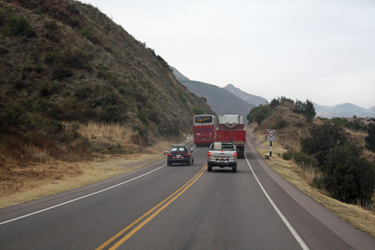 The duffels went in the way back, G and Bob in the back and I claimed the role of El Teniente so I could take pictures out the front as we headed to Tinqui. We departed old town Cusco and stopped on the way out of town to pick up Leo, who was one of the two arrieros that would haul the gear for the duration of trip. The route from Cusco trended south and was reputed to take about 5 or 6 hours to reach our trail head at the pueblo of Tinqui. We made good time on quality roads, passing slower traffic in the company of trucks and buses en route, a standard of travel south of the border. After passing the pueblo of ____ we cut east on the transoceanic highway, a route that connect Peru with Sao Paulo, Brazil, a trip that made John shake his The duffels went in the way back, G and Bob in the back and I claimed the role of El Teniente so I could take pictures out the front as we headed to Tinqui. We departed old town Cusco and stopped on the way out of town to pick up Leo, who was one of the two arrieros that would haul the gear for the duration of trip. The route from Cusco trended south and was reputed to take about 5 or 6 hours to reach our trail head at the pueblo of Tinqui. We made good time on quality roads, passing slower traffic in the company of trucks and buses en route, a standard of travel south of the border. After passing the pueblo of ____ we cut east on the transoceanic highway, a route that connect Peru with Sao Paulo, Brazil, a trip that made John shake his 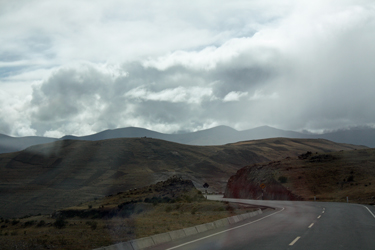 head at the thought of driving. Apparently it is quite a ride through mountains, jungle and other terrain that can be measured in kilometers or weeks, depending upon the season and other conditions. head at the thought of driving. Apparently it is quite a ride through mountains, jungle and other terrain that can be measured in kilometers or weeks, depending upon the season and other conditions.
The transoceanic highway took us up and over a high pass, the road wending its way through many switchbacks to achiever the highpoint. From the pass, we took in a much closer view of Ausangate and the surrounding peaks of the Vilcanota Range. These are big peaks, many over 600 meters and as was true for us in northern Peru, we knew we were not in Kansas anymore. The question would be whether there were any summits who technicality was within our range. We certainly did not expect to 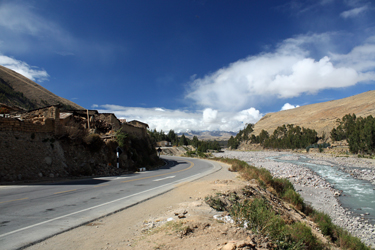 get skunked, but we also did not figure there was a 6000 meter peak that we would score on this trip. But that was OK, we would have a 12 day trek with climbing along the way, and getting a high summit was not really high on the priority list. get skunked, but we also did not figure there was a 6000 meter peak that we would score on this trip. But that was OK, we would have a 12 day trek with climbing along the way, and getting a high summit was not really high on the priority list.
We hit some showers here and there and I thought to myself . . ." I really don't want to make the approach in the rain and I really would like to avoid snow on the first night if possible." I suspect G and Bob may have had similar thoughts but we all were quiet as we took in the view of the mountains ahead. After about 4 hours we arrived in Ocangate, the last substantive pueblo before Tinqui proper. We took a breather here to stretch the legs and 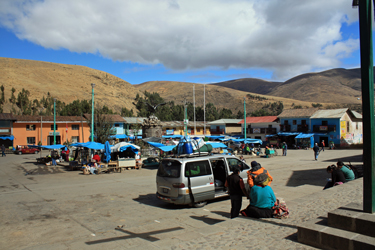 round up some smaller denomination bills for use along the trail as needed. Unlike Argentina, we held no doubts that we would be in populated valleys for the duration of the trek and that there might be need for small bills here and there. It was market day in Ocangate and all around the square locals were selling potatoes and other food stuffs. We purchased some soft drinks in order to break bills and then, with cambio in hand, we wandered about, scoped out a colonial era bridge, the central market, the town's condor sculpture, and then it was back in the van for the short half hour at most to Tinqui. round up some smaller denomination bills for use along the trail as needed. Unlike Argentina, we held no doubts that we would be in populated valleys for the duration of the trek and that there might be need for small bills here and there. It was market day in Ocangate and all around the square locals were selling potatoes and other food stuffs. We purchased some soft drinks in order to break bills and then, with cambio in hand, we wandered about, scoped out a colonial era bridge, the central market, the town's condor sculpture, and then it was back in the van for the short half hour at most to Tinqui.
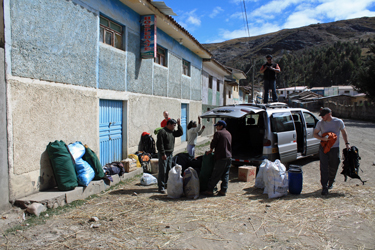 We pulled off the road and down a dirt street to the start of our approach into the Cordillera Vilcanota proper. We paid the local trail use fee and helped the crew get the mass of gear off the roof of the van so that it could be loaded on the horses when they arrived. Leo and our other arriero, Rocque, started laying out the gear into horse loads but before long, Domingo, our cook, was ready to go and there was no need for us to await the arrival of the horses. We were all going to Pachanta and I knew from prior trips that the horses would catch up to us no later halfway to Pachanta. We pulled off the road and down a dirt street to the start of our approach into the Cordillera Vilcanota proper. We paid the local trail use fee and helped the crew get the mass of gear off the roof of the van so that it could be loaded on the horses when they arrived. Leo and our other arriero, Rocque, started laying out the gear into horse loads but before long, Domingo, our cook, was ready to go and there was no need for us to await the arrival of the horses. We were all going to Pachanta and I knew from prior trips that the horses would catch up to us no later halfway to Pachanta.
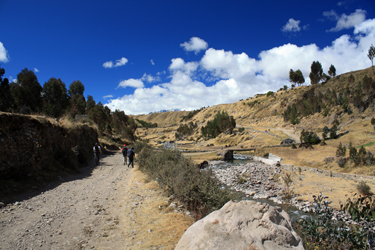 With our use fee paid and Domingo in the lead, we headed across a bridge and up the dirt road leading out of Tinqui. I had pre-programmed a number of way points into my GPS, so I knew the approximate distance to Pacchanta and that came up to about 6 crow fly miles. With twists and turns, we figured were up against 8 miles on foot at the very least. The road climbed out of town and made a hairpin back after again crossing the small river. We spotted a group of four horses being brought down from higher up and Domingo noted that that was the team that would haul gear for us over the next 12 days. Compared to the pack trains we've used in the past, these were full size horses as compared to the smaller ones we'd used in the Apolobamba and Argentina in years past. With our use fee paid and Domingo in the lead, we headed across a bridge and up the dirt road leading out of Tinqui. I had pre-programmed a number of way points into my GPS, so I knew the approximate distance to Pacchanta and that came up to about 6 crow fly miles. With twists and turns, we figured were up against 8 miles on foot at the very least. The road climbed out of town and made a hairpin back after again crossing the small river. We spotted a group of four horses being brought down from higher up and Domingo noted that that was the team that would haul gear for us over the next 12 days. Compared to the pack trains we've used in the past, these were full size horses as compared to the smaller ones we'd used in the Apolobamba and Argentina in years past.
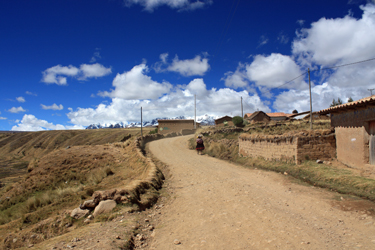 The road cut up through the higher reaches of Tinqui before we made a hard left and followed the dirt track as it seemed to make a straight line for the mountains ahead of us. The Vilcanota peaks were shrouded in bright white clouds but the weather did not look bad, it seemed more like the peaks were making their own weather in the afternoon heat. We would later find that his was exactly the case once we established our camps in the Cordillera proper. Meanwhile, we walked on, passing groups of kids and adults here and there, going to and from school or work in the fields. We made out best effort with respect to using the Quechua 'how goes" greeting but we buggered the pronunciation up so badly that every school kid The road cut up through the higher reaches of Tinqui before we made a hard left and followed the dirt track as it seemed to make a straight line for the mountains ahead of us. The Vilcanota peaks were shrouded in bright white clouds but the weather did not look bad, it seemed more like the peaks were making their own weather in the afternoon heat. We would later find that his was exactly the case once we established our camps in the Cordillera proper. Meanwhile, we walked on, passing groups of kids and adults here and there, going to and from school or work in the fields. We made out best effort with respect to using the Quechua 'how goes" greeting but we buggered the pronunciation up so badly that every school kid 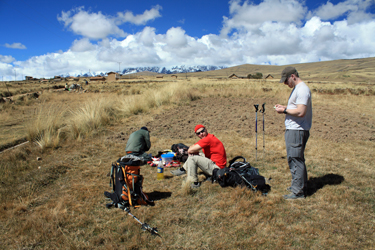 found our diction wanting. They generally responded with a mocking repetition of our vain effort which in turn was followed by laughter as a group. found our diction wanting. They generally responded with a mocking repetition of our vain effort which in turn was followed by laughter as a group.
We walked this straight line road for a number of miles, stopping after about the second mile for lunch. Domingo was well prepared and soon he was pouring Inca Cola into plastic cups and dispensing chicken salad on freshly washed plates. This was a good omen as to the ever present stomach bug that seems to wait around every corner on a trip like this. We took about a half hour for lunch before packing our leftovers and returning to the road for some more hiking. As we gained elevation, the number of farmsteads decreased as did the number of kids walking the road to return home after school. We found by the end of the day, that some of these kids were walking 3 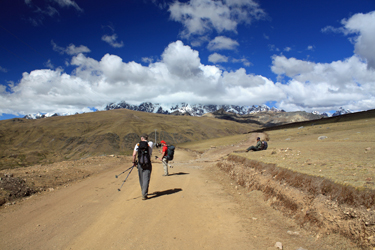 miles in each direction, a level of dedication long unheard of on our home turf for sure. miles in each direction, a level of dedication long unheard of on our home turf for sure.
The road climbed and climbed and after about two hours, the horse team with Rocque and Leo passed us and took the lead. I long ago learned that you are not going to arrive in camp before the pack team, it seems to be an unbroken rule. perhaps they will be only 2 minutes ahead but they will be ahead of you. We crossed the 15,000 foot mark and dipped into a valley, heading toward a pueblo that we assumed was probably Pacchanta. The whole town seemed turned out to build a building, a school/community house per Domingo, and we stopped to watch the forming of adobe blocks and the construction proper. Adjacent to our stopping 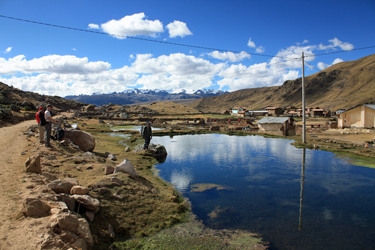 point was a good sized pond, filled with many trout. The community obviously was involved in fish farming as well as planting the usual potato crop. point was a good sized pond, filled with many trout. The community obviously was involved in fish farming as well as planting the usual potato crop.
Well . . . we were not in Pacchanta yet, so we walked on out of this pueblo and through a rocky area, now heading up again but not gaining too much elevation. The road twisted and turned, and eventually cut across a sodden flat bounded on the uphill side by rock precipitated from hot spring waters. We knew that Pacchanta had thermal springs so this must be the place crossed our minds. We passed through the gap between a couple of buildings and were told that the flat spot on the other side was the camp ground. We had everything 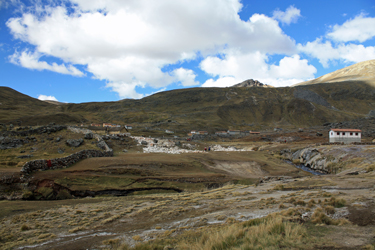 we needed, flat spots for tents, llama dung on the ground for padding, and the promise of a soak in a hot pool when we were ready. we needed, flat spots for tents, llama dung on the ground for padding, and the promise of a soak in a hot pool when we were ready.
However, before we even set up camp, we were beset upon by he local ladies selling hand crafted items, that is hand crafted somewhere by someone, but likely locally made. I am rarely in the market for such items, having no kids, so Bob took on the task of purchasing something to bring the marketing session to a semi agreeable end. I think he ended up with a knit hat and some beaded bracelets, enough to give him a feel for the haggling process and enough of distraction that I could set my tent up.
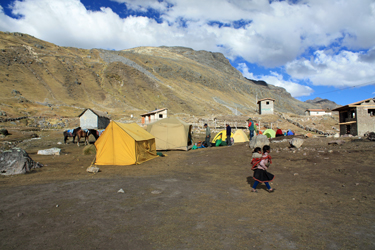 As to the group camping arrangements, we were in the dark until this point as to the degree of cush Carlos planned for this trek. We found out soon, that his standard was on the par with Argentina as to feed and tentage. Leo and Rocque set up a big family style tent for eating, complete with a folding table and stools as well as a separate cook tent, where Domingo plied his trade. We had already determined that we would all sleep in small one person tents, a decision based on prior trips where group tenting generously allowed everyone to share the same coughs and disorders. The use of separate tents gave everyone some personal space but more importantly seems to isolate the crud or at least slow the progress of illness through the As to the group camping arrangements, we were in the dark until this point as to the degree of cush Carlos planned for this trek. We found out soon, that his standard was on the par with Argentina as to feed and tentage. Leo and Rocque set up a big family style tent for eating, complete with a folding table and stools as well as a separate cook tent, where Domingo plied his trade. We had already determined that we would all sleep in small one person tents, a decision based on prior trips where group tenting generously allowed everyone to share the same coughs and disorders. The use of separate tents gave everyone some personal space but more importantly seems to isolate the crud or at least slow the progress of illness through the 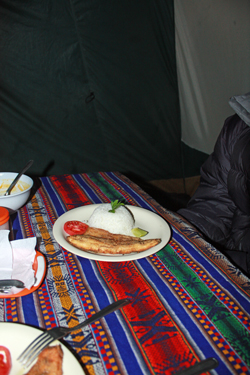 group. group.
We had covered about 8 miles and were ready for dinner. Domingo did not disappoint and when dinner was served it was fresh fish, rice, after a bowl of soup to start the affair off. Dinner is not complete without dessert and the chocolate pudding fit the bill for sure. Our next task was to determine the game plan for the next day . . . a rest day in Pacchanta or another day's hike of about 8 miles to a camp below Campa Pass. We'd been going pretty much non stop since leaving Cheyenne and we knew from prior trips that a rest day had to be in the cards. Pacchanta has a hot spring and a soak never hurt anyone. A day in Pacchanta seemed more prudent than a colder rest day at the next higher spot. We resisted the common and driving 'let's get climbing" urge and advised the crew that we would sit tight in Pacchanta for a day of rest.
|

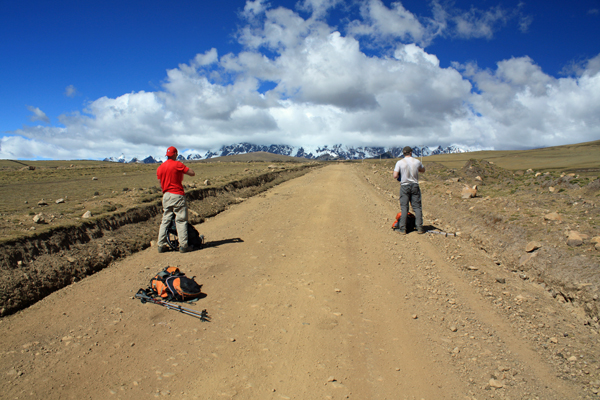
 The duffels went in the way back, G and Bob in the back and I claimed the role of El Teniente so I could take pictures out the front as we headed to Tinqui. We departed old town Cusco and stopped on the way out of town to pick up Leo, who was one of the two arrieros that would haul the gear for the duration of trip. The route from Cusco trended south and was reputed to take about 5 or 6 hours to reach our trail head at the pueblo of Tinqui. We made good time on quality roads, passing slower traffic in the company of trucks and buses en route, a standard of travel south of the border. After passing the pueblo of ____ we cut east on the transoceanic highway, a route that connect Peru with Sao Paulo, Brazil, a trip that made John shake his
The duffels went in the way back, G and Bob in the back and I claimed the role of El Teniente so I could take pictures out the front as we headed to Tinqui. We departed old town Cusco and stopped on the way out of town to pick up Leo, who was one of the two arrieros that would haul the gear for the duration of trip. The route from Cusco trended south and was reputed to take about 5 or 6 hours to reach our trail head at the pueblo of Tinqui. We made good time on quality roads, passing slower traffic in the company of trucks and buses en route, a standard of travel south of the border. After passing the pueblo of ____ we cut east on the transoceanic highway, a route that connect Peru with Sao Paulo, Brazil, a trip that made John shake his  head at the thought of driving. Apparently it is quite a ride through mountains, jungle and other terrain that can be measured in kilometers or weeks, depending upon the season and other conditions.
head at the thought of driving. Apparently it is quite a ride through mountains, jungle and other terrain that can be measured in kilometers or weeks, depending upon the season and other conditions. get skunked, but we also did not figure there was a 6000 meter peak that we would score on this trip. But that was OK, we would have a 12 day trek with climbing along the way, and getting a high summit was not really high on the priority list.
get skunked, but we also did not figure there was a 6000 meter peak that we would score on this trip. But that was OK, we would have a 12 day trek with climbing along the way, and getting a high summit was not really high on the priority list. round up some smaller denomination bills for use along the trail as needed. Unlike Argentina, we held no doubts that we would be in populated valleys for the duration of the trek and that there might be need for small bills here and there. It was market day in Ocangate and all around the square locals were selling potatoes and other food stuffs. We purchased some soft drinks in order to break bills and then, with cambio in hand, we wandered about, scoped out a colonial era bridge, the central market, the town's condor sculpture, and then it was back in the van for the short half hour at most to Tinqui.
round up some smaller denomination bills for use along the trail as needed. Unlike Argentina, we held no doubts that we would be in populated valleys for the duration of the trek and that there might be need for small bills here and there. It was market day in Ocangate and all around the square locals were selling potatoes and other food stuffs. We purchased some soft drinks in order to break bills and then, with cambio in hand, we wandered about, scoped out a colonial era bridge, the central market, the town's condor sculpture, and then it was back in the van for the short half hour at most to Tinqui.  We pulled off the road and down a dirt street to the start of our approach into the Cordillera Vilcanota proper. We paid the local trail use fee and helped the crew get the mass of gear off the roof of the van so that it could be loaded on the horses when they arrived. Leo and our other arriero, Rocque, started laying out the gear into horse loads but before long, Domingo, our cook, was ready to go and there was no need for us to await the arrival of the horses. We were all going to Pachanta and I knew from prior trips that the horses would catch up to us no later halfway to Pachanta.
We pulled off the road and down a dirt street to the start of our approach into the Cordillera Vilcanota proper. We paid the local trail use fee and helped the crew get the mass of gear off the roof of the van so that it could be loaded on the horses when they arrived. Leo and our other arriero, Rocque, started laying out the gear into horse loads but before long, Domingo, our cook, was ready to go and there was no need for us to await the arrival of the horses. We were all going to Pachanta and I knew from prior trips that the horses would catch up to us no later halfway to Pachanta. With our use fee paid and Domingo in the lead, we headed across a bridge and up the dirt road leading out of Tinqui. I had pre-programmed a number of way points into my GPS, so I knew the approximate distance to Pacchanta and that came up to about 6 crow fly miles. With twists and turns, we figured were up against 8 miles on foot at the very least. The road climbed out of town and made a hairpin back after again crossing the small river. We spotted a group of four horses being brought down from higher up and Domingo noted that that was the team that would haul gear for us over the next 12 days. Compared to the pack trains we've used in the past, these were full size horses as compared to the smaller ones we'd used in the Apolobamba and Argentina in years past.
With our use fee paid and Domingo in the lead, we headed across a bridge and up the dirt road leading out of Tinqui. I had pre-programmed a number of way points into my GPS, so I knew the approximate distance to Pacchanta and that came up to about 6 crow fly miles. With twists and turns, we figured were up against 8 miles on foot at the very least. The road climbed out of town and made a hairpin back after again crossing the small river. We spotted a group of four horses being brought down from higher up and Domingo noted that that was the team that would haul gear for us over the next 12 days. Compared to the pack trains we've used in the past, these were full size horses as compared to the smaller ones we'd used in the Apolobamba and Argentina in years past.  The road cut up through the higher reaches of Tinqui before we made a hard left and followed the dirt track as it seemed to make a straight line for the mountains ahead of us. The Vilcanota peaks were shrouded in bright white clouds but the weather did not look bad, it seemed more like the peaks were making their own weather in the afternoon heat. We would later find that his was exactly the case once we established our camps in the Cordillera proper. Meanwhile, we walked on, passing groups of kids and adults here and there, going to and from school or work in the fields. We made out best effort with respect to using the Quechua 'how goes" greeting but we buggered the pronunciation up so badly that every school kid
The road cut up through the higher reaches of Tinqui before we made a hard left and followed the dirt track as it seemed to make a straight line for the mountains ahead of us. The Vilcanota peaks were shrouded in bright white clouds but the weather did not look bad, it seemed more like the peaks were making their own weather in the afternoon heat. We would later find that his was exactly the case once we established our camps in the Cordillera proper. Meanwhile, we walked on, passing groups of kids and adults here and there, going to and from school or work in the fields. We made out best effort with respect to using the Quechua 'how goes" greeting but we buggered the pronunciation up so badly that every school kid  found our diction wanting. They generally responded with a mocking repetition of our vain effort which in turn was followed by laughter as a group.
found our diction wanting. They generally responded with a mocking repetition of our vain effort which in turn was followed by laughter as a group.  miles in each direction, a level of dedication long unheard of on our home turf for sure.
miles in each direction, a level of dedication long unheard of on our home turf for sure. point was a good sized pond, filled with many trout. The community obviously was involved in fish farming as well as planting the usual potato crop.
point was a good sized pond, filled with many trout. The community obviously was involved in fish farming as well as planting the usual potato crop.  we needed, flat spots for tents, llama dung on the ground for padding, and the promise of a soak in a hot pool when we were ready.
we needed, flat spots for tents, llama dung on the ground for padding, and the promise of a soak in a hot pool when we were ready. As to the group camping arrangements, we were in the dark until this point as to the degree of cush Carlos planned for this trek. We found out soon, that his standard was on the par with Argentina as to feed and tentage. Leo and Rocque set up a big family style tent for eating, complete with a folding table and stools as well as a separate cook tent, where Domingo plied his trade. We had already determined that we would all sleep in small one person tents, a decision based on prior trips where group tenting generously allowed everyone to share the same coughs and disorders. The use of separate tents gave everyone some personal space but more importantly seems to isolate the crud or at least slow the progress of illness through the
As to the group camping arrangements, we were in the dark until this point as to the degree of cush Carlos planned for this trek. We found out soon, that his standard was on the par with Argentina as to feed and tentage. Leo and Rocque set up a big family style tent for eating, complete with a folding table and stools as well as a separate cook tent, where Domingo plied his trade. We had already determined that we would all sleep in small one person tents, a decision based on prior trips where group tenting generously allowed everyone to share the same coughs and disorders. The use of separate tents gave everyone some personal space but more importantly seems to isolate the crud or at least slow the progress of illness through the  group.
group.